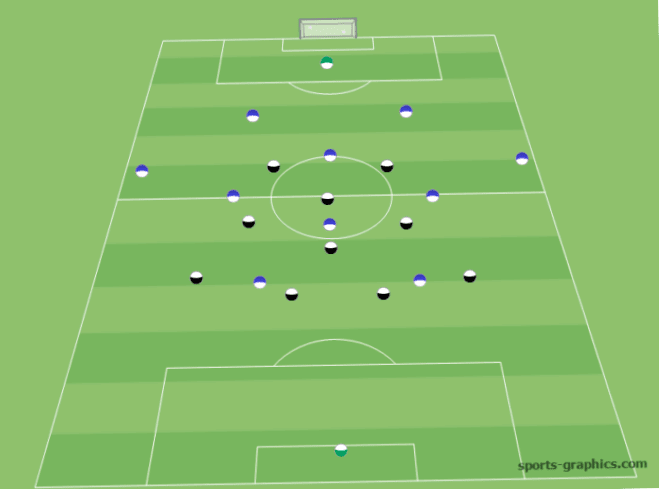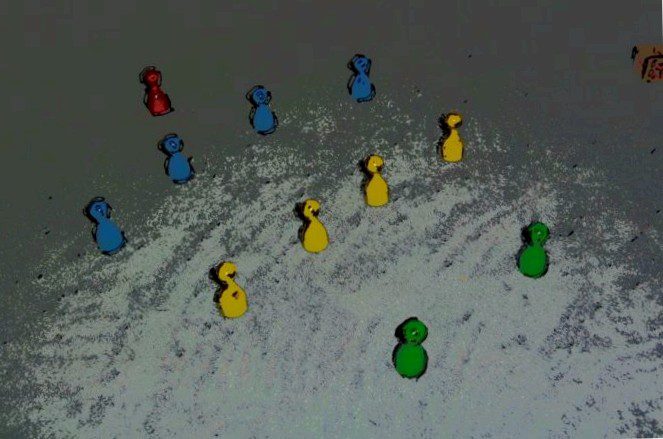The 4-4-2 system (especially with a flat four) lends itself to teams that function well as a team but don’t have outstanding individual players. This is especially true because the big challenge in the 4-4-2 system due to the symmetry is that each player fulfills his task (defensively as well as offensively) and supports his teammates optimally. The 4-4-2 with a rhombus is more complicated in this respect. Because it is less balanced in the distribution of space. The 4-4-2 with diamond relies more on the individual strengths of the players, especially in midfield.
The 4-4-2 system and its variants:

4-4-2 system with diamond
In games with a 10-man and a 6-man (diamond in midfield), I have noticed that the defense is no longer as stable when the 10-man interprets his role too offensively (which happens again and again). Also, the strain on him is greater if he is supposed to set offensive accents behind the top players and then immediately switches to defense. The 4-4-2 system with a diamond in the midfield is therefore more suitable against somewhat weaker opponents, when you have to make the game yourself and act offensively.
Then you still need a strong 6-man, who alone does a lot of the defensive work and “works in” well. Werder Bremen liked to act under Thomas Schaaf in this formation and played very center-oriented.
Advantages of the 4-4-2 system with diamond
The 4-4-2 with a diamond in the midfield offers an extremely compact formation with a good staggering in the midfield. This is especially true for the depth arrangement with 3 midfield lines (one 10, two 8, one 6). This makes it well suited to dominate the midfield, especially in the center. The many options for forming triangles help with short-pass combination play. This allows for the short game to be played both inside and out.
Disadvantages of the 4-4-2 system with diamond
The system’s great compactness in the center results in its greatest weakness: the wings are often manned only by fullbacks, which can lead to shorthanded situations against teams that focus on wing play. If you let your outside midfielders move further to the wing, you give up some of your central compactness.only 1 six in front of the defense (unless you play defensively as a 4-3-1-2 system).
4-4-2 system with flat four
The 4-4-2 system with flat four is in soccer is one of the most popular formations of team tactics. This system of play is characterized by a good balance and great flexibility: with the smallest adjustments, other formations can be quickly derived from this basic formation, even within a game. Thus, the 4-4-2 with a flat four can quickly become a 4-4-1-1 (with a hanging top) or a 4-5-1 (with an additional midfielder).
In midfield, it can be seen that the back four is advantageous defensively, as the running distances are relatively short for everyone, especially when it comes to doubling in the center or even helping out on the wing. At the same time I always have at least one six in the center in front of the defense, who can support the center backs when his sidekick (the second six) moves out to the wing. Many teams that nominally play in a 4-2-3-1 system switch to a 4-4-2 system with a flat four on defense. This has the advantage that you can initiate pressing situations very well with two players up front, if you play tilting (closing the middle) and the striker far from the ball pushes through to help win the ball.
The difference in tactics is not so much in the distribution of numbers but in the individual behavior of the players on the respective position: If I have a striker who likes to pick up the balls in midfield, the 4-4-2 will quickly turn out like the 4-4-1-1 already mentioned above.

Advantages of the 4-4-2 system with a flat back four
A particular advantage of the system is that the double wings can be used both offensively and defensively. wingers and full-backs can support each other very well (if the player types match). This leads to pressure wing play in attack. The outside players should be strong (not necessarily dribbling strong) to enable combinations on the outside or from the outside into the center. Together with an offensive-minded fullback who times his attacking actions well, such a player can make a lot of business.
Disadvantages of the 4-4-2 system with flat four
In the offensive it can be difficult to get connections between the midfield and the strikers because of the lack of depth. This is mainly because central midfielders often have to work very far backwards. The central midfield must therefore actually be occupied by two box-to-box players. result is often very fast, direct play (actually not a disadvantage) with passes over the middle distance. The build-up often takes place via the outside because of the double-occupied wings. This possibly favors better pressing situations for the opponent.
Pressing and defending in a 4-4-2 with a flat back four
Defensively, the 4-4-2 with a flat four works very well if you want to play simple pressing variations and are relatively homogeneous as a team (that doesn’t necessarily mean well). However, each player must fit into the team’s play and tactical alignment, and perform his role in a disciplined manner. Because if gaps open up at any point in the system, the advantage of tactical balance quickly becomes a disadvantage. The 4-4-2 with a flat four offers little space for outstanding individual players who cannot blend in.
The flat four in midfield makes for short running routes, which makes it easier to double in the center between midfield and defense. The two sixes can alternate on the wing and support the center backs in front of the defense. Many teams that nominally play in a 4-2-3-1 system switch to a 4-4-2 system with a flat four in defense. This has the advantage of being very good at initiating pressing situations with two players up front, if you play off-sides (close the middle) and the striker away from the ball pushes through to help win the ball.
4-4-2 with a flat four at a glance:
- balanced distribution of players across the pitch, short runs to support
- double-staffed wings in offense and defense
- strong center in defense, if the two strikers cooperate to the back
- easy to learn and flexible
- Depth staggering not optimal against teams with 3 central midfielders
The 4-4-2 system with a back four (flat four) in midfield has great advantages if you have strong (not necessarily dribble strong) outfield players. If you have a pairing of outside back and outside midfielder here that e.g. can also change positions and often play through on the wing, you always get into the back of the opponent’s back four.
With the two strikers, if they work consistently, it is always possible to put the opponent under pressure early and initiate midfield or attacking pressing (forechecking), depending on the player material (if you have hardworking strikers) better than with e.g. five midfielders.
Comparison of the 4-4-2 with other playing systems
4-3-1-2 as a good alternative to 4-4-2
An alternative to the 4-4-2 system with a flat four, which I have also played time and again, is a 4-3-1-2 with one very offensive midfielder and three very defensive ones. This has the advantage of a very strong, dense center. You can use this if you only have a few offensive midfielders available and you want to be compact.
This is how you act when you first don’t want to lose, but want to avoid conceding a goal. The two strikers (if they are willing to run) always give you the chance to play dangerous counterattacks. Also, with two tips, you can put very good pressure on the opposing center backs.